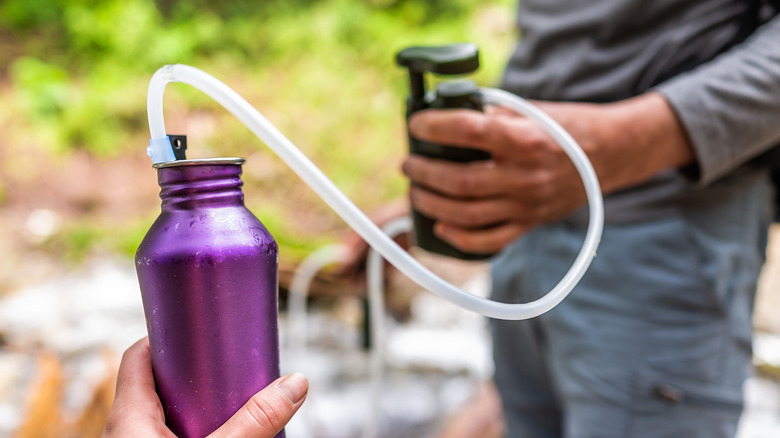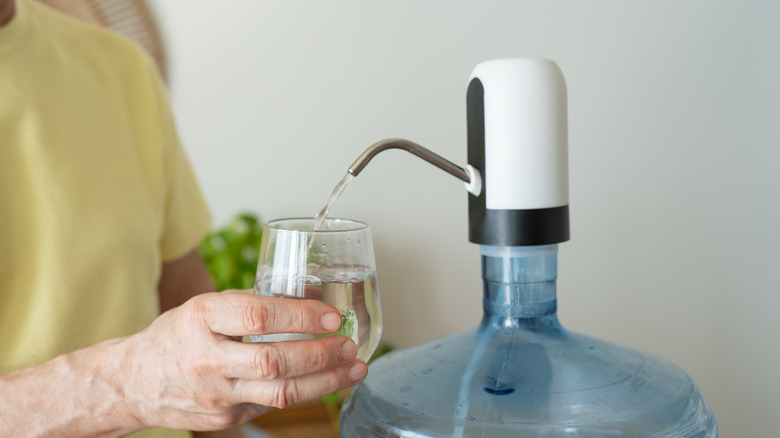One Popular Piece Of Hiking Gear Can Protect Your Health While Traveling Abroad
Picture this: You've just landed in an exciting, unfamiliar country, buzzing with anticipation for the adventures ahead. Your itinerary is packed — exploring ancient ruins, savoring delicious street food, hiking rugged trails. But by day two, your dream trip takes a grim turn. You're confined to a cramped hostel bathroom, clutching the toilet bowl, regretting that glass of tap water you thought was fine. The vibrant markets and scenic views fade into a haze of nausea and exhaustion. This isn't just a ruined vacation, it's a harsh reminder of how something as simple as water can derail your plans.
Globally, access to clean water remains a critical issue. In 2022, approximately 1.7 billion people relied on drinking water contaminated with fecal matter, according to the World Health Organization. Waterborne pathogens include bacteria like Escherichia coli (E. coli), viruses like hepatitis A, and Giardia thrive in untreated water, especially in regions with limited sanitation infrastructure. These invisible threats cause illnesses ranging from mild diarrhea to severe conditions like cholera or typhoid fever. For travelers, particularly in developing nations, the risk is amplified by unfamiliar water systems and inconsistent quality control.
The Centers for Disease Control and Prevention (CDC) strongly advises travelers to carry a water purification system, a popular piece of hiking gear, especially for extended trips or visits to remote areas. Unlike bottled water, which may be unavailable or environmentally costly, portable purifiers offer a reliable, eco-friendly solution. By neutralizing pathogens, these devices ensure safe drinking water, protecting your health and preserving your adventure.
Water filtration vs. water purification and why it matters
Not all water treatment methods are created equal, and understanding the distinction between filtration and purification is crucial for travelers. Water filtration, like systems found in household pitchers, physically strains out larger particles, bacteria, and protozoa. These filters excel at removing sediment and microbes like Giardia or Cryptosporidium, improving taste and clarity. However, their pore sizes can often be too large to capture viruses, which are significantly smaller. Hepatitis A or other viruses that are common in contaminated water can slip through, posing serious health risks.
Water purification, by contrast, tackles all three pathogen classes: bacteria, protozoa, and viruses. Purification systems often combine filtration with additional methods, such as chemical treatment or ultraviolet (UV) light, to neutralize viruses. For example, a pump purifier may filter out bacteria and protozoa, then use iodine-based chemicals to eliminate viruses. UV purifiers, like portable wands, emit rays that disrupt the DNA of all pathogens, rendering them harmless. This comprehensive approach is vital in regions where viral contamination is a concern, such as areas recovering from natural disasters or with poor water sanitation.
Choosing purification over filtration ensures broader protection, particularly in high-risk environments. While filtration improves water aesthetics, only purification guarantees safety against the smallest, most insidious threats, viruses, making it the preferred choice for international travel.
Choosing the right water purification system
Selecting a water purification system depends on your travel style, budget, and destination. Several options exist, each with its own unique benefits and drawbacks. Pump purifiers, like the Katadyn Hiker Pro, process large volumes quickly, ideal for group travel or murky water sources. However, they can be bulky, require maintenance, and need compatible containers. UV purifiers, such as the SteriPEN Ultra, are lightweight and fast, treating water in seconds without the need for replaceable parts. Yet, they rely on batteries and struggle with turbid water, limiting their versatility.
Bottle purifiers like the LifeStraw Go, integrate filtration and purification into a single container, perfect for solo travelers. They're user-friendly but limited to small volumes of water, and cartridges need periodic replacement. Chemical purifiers like Aquatabs or Potable Aqua Purification Tablets are compact and budget-friendly, some can treat up to 64 oz of water per tablet. Yet they require a waiting period, may leave a slight chemical taste, and are less effective against certain protozoa like Cryptosporidium.
When choosing your purification system, consider water source quality, trip duration, and group size. Research reputable brands and read user reviews to find a system best suited to your needs. A reliable purifier not only safeguards your health for your next international adventure getaway in some of the prettiest waters around the world, just remember not to pack this seemingly harmless and unexpected household item that's restricted from all flights to Canada.


